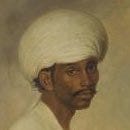Infinity Structure, Infinity Mercy, Infinity Vengeance
As Ramadan commences, I want to reflect on the artwork Infinite Structure by the Lebanese artist Saloua Raouda Choucair which is in the Tate collection.
In a global pandemic, this year Ramadan, like other spaces and symbolic events of prayer, practice and community, it will be restricted for many in isolation and in various degrees of hardship. A hardship increased for so many across the globe, offshoots of the gluttonous West, historically and in the present. In such circumstances as now, whilst many aspects of Ramadan may feel unfamiliar, stunted or distorted, the resonance found within this month will always flourish in abundance.
I see one of these points of resonance in Ramadan, the quiet and reflective side of this month to consider your own belief, in the artwork Infinite Structure. An unassuming piece, but when seen displayed in the context of Tate Modern, it feels at home in a space that centres Western abstraction as a reference point. A space that perhaps represents a modern ideal that vacuumed out tradition and belief, creating a remarkable quasi-temple where stacked bricks can be said to have profound depth and meaning. Maybe this is the modern art of our museums, a space to compensate for de-centring and fracturing God and furnishing a secular with a form of transcendence.
Choucair created art within this idea of Western abstraction, but just with all her work, she was always informed by a deep reverence of Islamic tradition, design and philosophies. In this piece, she references the endless meaning found within the structure of Sufi poetry, which each block, each element of the full structure, itself rich with depth and individual meaning. In the best of Sufi poetry, you find yourself lost for an endless time in the profundity of a single verse. With its allusion to the infinite, it connects with the presence of tawhid in classical Islamic design, the oneness of Allah, where there is no start nor end line. In the context of this artwork, and when it is displayed in the art museum, in many ways the priority of meaning is its relation to Western abstraction or at best equates tawhid to be equal to this in meaning.
During Ramadan, this is what I want to reflect on personally, how compromised is my belief in Allah, when my education, societal contributions and cultural identity has been and is saturated in an acute version of modernity and liberal civic society. By even having access or finding spiritual resonance within a piece such as Choucair’s, what does this say about the framing of my belief? Has my association to transcendence been codified to the secular, where something like Western abstraction is a reference to access a spiritual fulfilment to connect with Allah? Does the very existence of Choucair’s work diminish the tradition of Islamic belief by moving it into an echo of Western art history?
These are all questions I want to reflect on this Ramadan. Even if I find this artwork as a vessel that connects me to the oneness of Allah, when I see the evocation of the infinite in this work, I instantly think of Allah, as ar-Rahim, who can encapsulate a mercy that stretches without end and a mercy to all of humanity. This instant thought, as powerful and rooted in tradition as it is, also makes me question, is this informed by what names of Allah are most accepted within a liberal secular society? What happens if I claim this piece allows me most to see the infinite as Allah, al-Muntaqim, whose vengeance beyond comprehension should cause fear to truly believe? Does it no longer fit within the context of an acceptable or welcomed expression of religion in public domain?
I see these questions in the artwork Infinity Structure, I see the resonance of quiet reflection in this piece too — these are my questions and focus this Ramadan when the functional purpose of congregation and connection that I usually associate with accessing the resonance within the month is missing.
